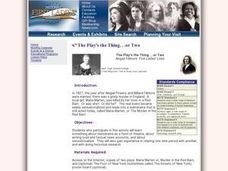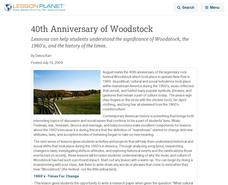EngageNY
Getting to Know Esperanza (Chapter 2: “Las Uvas/Grapes”)
Delve into Esperanza Rising by Pam Muñoz Ryan with close reading and evidence-based, text-dependent questions. Part of a unit series, this well-sequenced, Common Core designed instructional activity draws on material from the previous...
EngageNY
Research: Identifying Categories for Our Research About the Wheelwright
Here is a fine lesson on reading and understanding expository text designed for 4th graders. With a partner, learners read a passage of text about a machine called a wheelright. This machine was commonly used in the colonial period....
Learning to Give
What Are Your Thoughts?
The varying responses of the characters in Mildred Taylor's Roll of Thunder, Hear My Cry to the discrimination they experience or perpetrate provides readers with an opportunity to not only examine the feelings of the characters but to...
Turabian Teacher Collaborative
Parts of Argument II: Article Critique
Break down the parts of argumentative writing with a critical thinking activity. High schoolers read an article of your (or their choice), and use a graphic organizer to delineate the ways the author structures his or her arguments.
Curated OER
Titanic Facts and Figures
Looking for a way to include math in your history lesson on the Titanic? In this instructional activity, historians read a paragraph containing facts and figures about the Titanic, then use the background information to answer 4...
Curated OER
Historical Fashions - Interdisciplinary Experience, Art & Social Studies
Seventh graders research styles, construction, fabrics, colors, and cost of Colonial era clothing. They create a life-sized model of themselves wearing Colonial period clothing and write a report about the clothes they designed.
Curated OER
Lincoln Home National Historic Site: A Place of Growth and Memory
Eighth graders study the history of Lincoln's home. In this American History lesson, 8th graders examine artifacts from his home to learn about his beliefs. Students participate in a webquest on Lincoln's home.
Curated OER
A Monumental Race
Learners write about the importance of historical sites and landmarks. They research information about an ancient historical site and create a plan for commemorating this site.
Curated OER
Through the Looking Glass
Students conduct Internet 'treasure hunts' to explore how everyday items, both in their antique and modern forms, possess historic and cultural significance.
Curated OER
Nothing to Fear
Sixth graders read from the book, "Nothing to Fear," and discuss living in New York during the Great Depression. They write entries and summaries in their learning logs to share with the class. They work in groups to create a database...
Curated OER
Black History Stamps
Students explore the lives and contributions of the many black Americans who are honored on U.S. commemorative postage stamps, make a presentation that synthesizes information about a historical figure and time, and write a persuasive...
Curated OER
Front Page History
Learners consider how current events are directly and intricately tied to past events, decisions and other influences. The island of Guam is used as a case study as the events of WWII have continued to affect the people of Guam today.
Curated OER
Taking the Witness Stand
Students identify a pivotal event in world history that they would have liked to have witnessed. They then research this event and write a first-person account of it as if they had been present. Their first-prerson account is modeled...
Curated OER
Reconstruction to Civil Rights
Eighth graders complete a unit of lessons on the period of time from Reconstruction to the Civil Rights movement. They analyze and interpret political cartoons and editorials, conduct research on famous civil rights places, and complete...
National First Ladies' Library
The Play's the Thing...or Two
Students explore melodram as a form of theatre. They write about lucid and factual news accounts and about sensationalism. Students gain experience in relating one time period with another and with doing historical research.
Curated OER
History Through Picture Books and Photographs
First graders become familiar with historical figures central to the Underground Railroad and anti-slavery.
Curated OER
George Washington as Military Leader
Students will analyze historical evidence including primary sources to evaluate George Washington as a military leader. The reading begins with Washington's understanding of the issues related to military power, continues with his use of...
Curated OER
Civil War
Students are be able to analyze primary sources (Civil War images) for examples of how soldiers are portrayed historically. They discuss what a hero is and why some individuals are heroes to certain groups while others are not.
Curated OER
Harlem Renaissance and Toni Morrison's Jazz
Students study the historical time of the Harlem Renaissance, including key events and figures. They read literature that weaves fiction and history and survey some of the references to the Harlem Renaissance in the novel, Jazz, by Toni...
Curated OER
40th Anniversary of Woodstock
Lessons can help students understand the significance of Woodstock, the 1960's, and the history of the times.
Curated OER
The Fog of War
Students view the film Fog of War and discuss the most striking elements of the film. They focus on chosen lessons from robert McNamara's life such as: empathy, rationality and proportionality.
Curated OER
The Muckrakers Interdisciplinary Unit
Eighth graders complete an Interdisciplinary Unit on the Muckrakers and the Progressive Movement. Students describe life in America and how Progressive Reformers changed it. identify specific problems and propose solutions. Students...
Curated OER
The Harlem Renaissance: Black American Traditions
Students examine the time period of the Harlem Renaissance. As a class, they are introduced to five artists and discuss their art and techniques. Using the internet, they also research the philosophers of the time period and how...
Curated OER
Inventors
Students identify two inventors from the time period 1880-1920. They include information detailing one product or technological advancement each inventor was responsible for. Students use specific language and detail to discuss how...

























